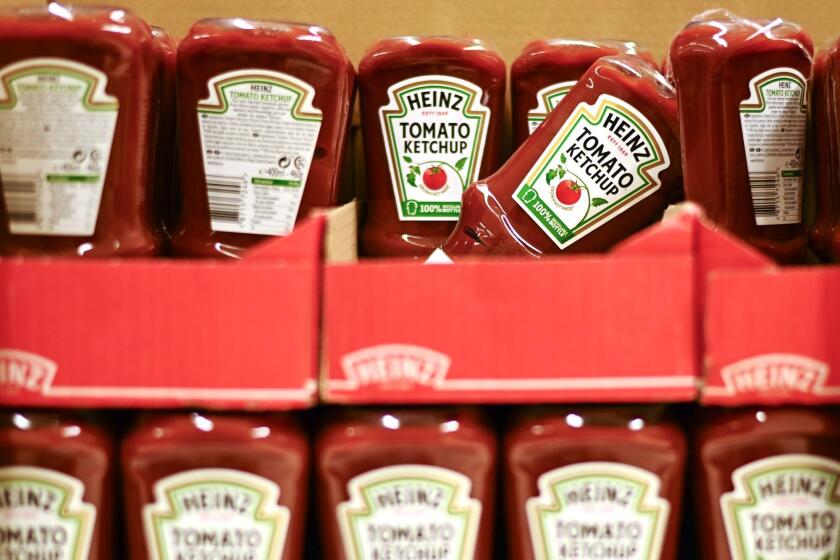Economy Shows Strong 4.3% Growth in Quarter : GNP Report Reflects Buildup in Inventories but Experts See a Slowdown; Trade Deficit Improves
- Share via
WASHINGTON — The nation’s economy expanded at an annual rate of 4.3% during the first three months of the year, far exceeding most expectations in and out of government, the Commerce Department reported Thursday.
But economists downplayed the strength of the report because much of it reflected a huge buildup of unsold inventories, while actual sales fell for the first time in a year.
The pattern led some economists to warn that the massive inventories, undercutting the need for substantial new production, could result in slow growth during the current quarter, continuing the seesaw pattern of the last year.
Analysts agreed that the continued improvement in the trade balance represents good news. The trade deficit improved at an annual rate of $13.8 billion in inflation-adjusted dollars.
Business Inventories Rise
The Commerce Department reported that business inventories grew by a whopping $59.5 billion in inflation-adjusted 1982 dollars during the first three months of 1987, while final sales of goods and services declined 2.2%.
While some analysts said that they fear slower growth ahead, others said that the inventory buildup and the decline in spending may merely be compensation for the year-end 1986 buying spree spurred by the new tax law. The law, which went into effect Jan. 1, eliminated the federal deduction for state and local sales taxes.
David Levine, an economist with the Sanford Bernstein & Co. investment banking firm in New York, calculated that if the massive purchases late last year of autos and business equipment had been spread out evenly over the two quarters, final sales would have been increased by 4.2 percentage points, while the huge inventory swing would have been leveled out.
The $13.8-billion decline in the trade deficit followed a $15.3-billion improvement in the last quarter of 1986.
U.S. sales of goods and services abroad declined at an annual rate of $1.6 billion, or 1.6%. But foreign imports, which had been surging for several years, plunged at an annual rate of $15.4 billion, or 11.1%. This followed a slight fourth-quarter decline of $700 million, or 0.5%, last year.
“Our trade balance has begun to swing in the right direction,” said Commerce Undersecretary Robert Ortner in a session with reporters. “These kinds of gains will give us a good leg up on (gross national product) growth for 1987.”
“That improvement of almost $14 billion in the trade balance is almost 10% of the total deficit, so it’s not to be ignored,” said Cynthia Latta of Data Resources Inc., a Lexington, Mass., forecasting firm. She conceded that Thursday’s report contains no hard trade figures for March and only preliminary ones for February, but she pointed out that future revisions “could just as easily be upward as down. So we’re feeling pretty good about this number.”
Levine of Sanford Bernstein cautioned that both the estimated import and export numbers may prove later to have been understated, especially if the economy manages to maintain a pace close to the first quarter’s strong growth rate. “On balance, I see a protracted rise in exports and relative weakness in imports,” he said.
Imbalance Tied to Dollar
In inflation-adjusted figures, the trade deficit has been declining for six months, as the dropping value of the dollar has made U.S. goods more competitive on the international market. But because of the dollar’s decline, the monetary value of imports has continued to rise in nominal terms, while the value of exports has shrunk.
During the quarter, import prices surged at an annual rate of 13.5%.
Douglas Handler of Wharton Economics, a Philadelphia forecasting firm, said that over time the prices of U.S. exports should be “firming, while import prices are soaring. That means we should begin to get better current dollar growth in exports and a possible future turnaround in the merchandise trade deficit.”
But uncertainty remains over the inventory question. Handler noted that the inventory accumulation during the quarter was “larger than expected and will probably steal growth from the next quarter. Now auto makers will have to slow production until demand catches up.”
Adverse Impact on Growth
By the same token, Data Resources’ Latta cautioned that “you can’t keep the economy growing by filling warehouse shelves and auto dealer lots.”
John O. Wilson, senior vice president and chief economist at Bank of America in San Francisco, predicted that growth in the current quarter would be only about 2%.
By contrast, Levine argued that growth should be greater than that, noting that the 2.2% decline in final sales during the first quarter was in part distorted by a huge drop in government purchases of farm production. That had no real impact on the GNP estimate, he said, because it was offset by a corresponding increase in farm inventories.
More to Read
Inside the business of entertainment
The Wide Shot brings you news, analysis and insights on everything from streaming wars to production — and what it all means for the future.
You may occasionally receive promotional content from the Los Angeles Times.










